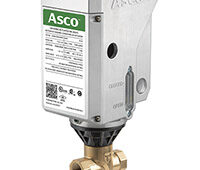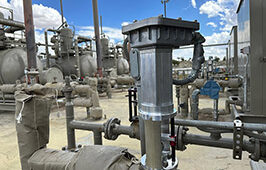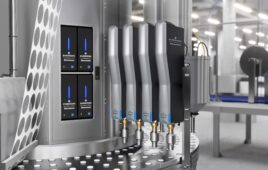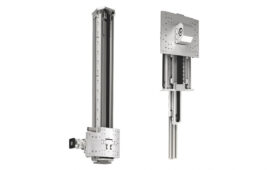
The Doosan Bobcat T7X on display at CES 2022 in Las Vegas features Moog electric cylinders and the Moog traction motor located at the uppermost point under the triangle forming the vehicle’s tracks.
Doosan Bobcat had a vision for designing and building an all-electric machine. Its team was looking for an all-electric actuator for its compact track loaders. The search led them to Moog, which has a history of converting hydraulic systems to electric ones. The result was the award-winning Bobcat T7X, which does not use hydraulic parts or oil. The T7X is a zero-emission and all-electric machine with the power and performance of a diesel-hydraulic machine but without the noise, emissions, and hydraulic leaks. Here’s how they did it.
The intelligent machine electrification system consists of an integrated software framework, a sophisticated electric machine controller, lift and tilt electric cylinders, electric traction motors, and power electronics. With the help of this new system, the T7X is a major step forward for the productivity, safety, and sustainability of construction machinery.
“Bobcat had a vision for an all-electric machine,” said Joe Baldi, director of strategy & partnerships for Moog. “Our conversation began with Moog’s all-electric actuators, but ultimately our talks led to the intelligent machine electrification system. Working together with Bobcat, we were able to bring that all-electric vision to life in six months.”
The new intelligent machine electrification system helped the T7X control the motion of the tracks and lift and tilt functions with efficiency, enabling a powerful zero-emission machine with increased run time and reduced maintenance costs.
“To describe our contribution to the T7X in anatomical terms,” added Baldi, “we supplied the brain’s frontal lobe (the part that controls motion); the nervous system helping to intelligently coordinate actions, power, and sensor information to and from different parts of the machine; and the muscles, which are the all-electric actuators and motors.”
On January 4, 2022, in Las Vegas at CES 2022, Doosan Bobcat announced that Sunbelt Rentals would invest in a fleet of the all-electric T7X compact track loaders. The all-electric machines will be co-branded by Bobcat and Sunbelt and made available this year.
So, what makes Moog’s solution an “automation-ready integrated system” versus a set of components for motion control and energy management? The digital software framework makes this solution automation-ready, enabling Bobcat to build digital and software-configurable machines for users. Each axis on the machine can be independently and precisely controlled, but they’re tied together with other sub-systems, making it easy for Bobcat to develop valuable functionality for their customers. Think of how Tesla and Apple introduce new features through software updates; Moog enables this with its system.

Pictured (L to R): Matt Sagaser, director of Innovation for Doosan Bobcat; Joe Alfieri; Nicole Wodka-Cook, business director for Moog Construction; Joel Honeyman, VP of Innovation for Doosan Bobcat; and Dave Grabau, business development manager for Moog Construction.
What’s unique (or first of its kind) about the offering for the Bobcat T7X is that it’s all-electric — no hydraulic parts, no oil, fewer parts than a diesel-electric machine; it’s zero-emission and quiet enough that construction crews can communicate without shouting or hand signals. The energy management software also gives the machine increased battery life because the machine supplies energy only to the parts of the machine when needed and in the correct amount. This extends battery life and makes zero-emission construction machines possible because they can do more work for longer before needing a charge.
Moog has experts in motion control, automation, simulation, modeling for whole systems and across markets ranging from aerospace to renewable energy. Today, most centralized systems on a construction vehicle have one motor and pump distributing hydraulic fluid; the pump is always running. With a traditional loader, the machine would waste energy on every axis for lifting, tilting, moving — even when the machine is stationary. Moog designed a more efficient system using distributed control to send power only when and where the T7X needed it, such as lifting dirt or moving side to side, so the T7X wastes little to no energy.
Additionally, the Moog team efficiently manages motion and thermodynamics for the T7X’s system, which keeps each component operating at the proper temperature range, reduces energy use, and extends run time.
Lastly, the new intelligent software optimizes the T7X’s motion as it carries out tasks by learning to smooth out the machine’s movements and operation, which boosts run time by more than 25%. The machine gets the same output and work done with less energy by smoothing out the peak moments of energy usage.
What is the “modular, scalable, platform approach?”
This means solutions like this one used for the Bobcat application are scalable across multiple types of machines with few modifications — it saves Bobcat time and money in developing its next all-electric product. Because the solution was built from modular hardware and software building blocks, the engineers on this project collaborated quickly to apply the blocks to different machines. The result? Zero-emission machines get to market faster and at a reduced cost.
How much time passed from the initial discussion to producing a working, all-electric loader?
Approximately six months.
How does Moog’s approach ensure electric vehicles have comparable force and torque to hydraulic systems?
The initial, all-electric solution for the T7X was thought to be too robust versus its hydraulic predecessor, but the intelligence of the machine systems allowed for different work modes to control the output when needed. There’s a misconception across many industries, not just construction, that hydraulic systems are stronger than electric ones. It takes the right experience to best apply the advantages of these different technologies to a machine.
Moog
www.moog.com/construction
Filed Under: Actuators




